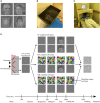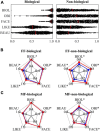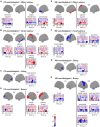Binocularly suppressed stimuli induce brain activities related to aesthetic emotions
- PMID: 38855441
- PMCID: PMC11159128
- DOI: 10.3389/fnins.2024.1339479
Binocularly suppressed stimuli induce brain activities related to aesthetic emotions
Abstract
Introduction: Aesthetic emotions are a class of emotions aroused by evaluating aesthetically appealing objects or events. While evolutionary aesthetics suggests the adaptive roles of these emotions, empirical assessments are lacking. Previous neuroscientific studies have demonstrated that visual stimuli carrying evolutionarily important information induce neural responses even when presented non-consciously. To examine the evolutionary importance of aesthetic emotions, we conducted a neuroscientific study using magnetoencephalography (MEG) to measure induced neural responses to non-consciously presented portrait paintings categorised as biological and non-biological and examined associations between the induced responses and aesthetic ratings.
Methods: MEG and pre-rating data were collected from 23 participants. The pre-rating included visual analogue scales for object saliency, facial saliency, liking, and beauty scores, in addition to 'biologi-ness,' which was used for subcategorising stimuli into biological and non-biological. The stimuli were presented non-consciously using a continuous flash suppression paradigm or consciously using binocular presentation without flashing masks, while dichotomic behavioural responses were obtained (beauty or non-beauty). Time-frequency decomposed MEG data were used for correlation analysis with pre-rating scores for each category.
Results: Behavioural data revealed that saliency scores of non-consciously presented stimuli influenced dichotomic responses (beauty or non-beauty). MEG data showed that non-consciously presented portrait paintings induced spatiotemporally distributed low-frequency brain activities associated with aesthetic ratings, which were distinct between the biological and non-biological categories and conscious and non-conscious conditions.
Conclusion: Aesthetic emotion holds evolutionary significance for humans. Neural pathways are sensitive to visual images that arouse aesthetic emotion in distinct ways for biological and non-biological categories, which are further influenced by consciousness. These differences likely reflect the diversity in mechanisms of aesthetic processing, such as processing fluency, active elaboration, and predictive processing. The aesthetic processing of non-conscious stimuli appears to be characterised by fluency-driven affective processing, while top-down regulatory processes are suppressed. This study provides the first empirical evidence supporting the evolutionary significance of aesthetic processing.
Keywords: aesthetic emotion; continuous flash suppression; magnetoencephalography; neuroaesthetics; vision.
Copyright © 2024 Hoshi, Ishii, Shigihara and Yoshikawa.
Conflict of interest statement
HH was employed by RICOH Co., Ltd. YS led a joint research project supported by RICOH Co., Ltd and another project supported by ITO EN, Ltd. The remaining authors declare that the research was conducted in the absence of any commercial or financial relationships that could be construed as a potential conflict of interest. The author(s) declared that they were an editorial board member of Frontiers, at the time of submission. This had no impact on the peer review process and the final decision.
Figures






Similar articles
-
Subliminal presentation of emotionally negative vs positive primes increases the perceived beauty of target stimuli.Exp Brain Res. 2015 Nov;233(11):3271-81. doi: 10.1007/s00221-015-4395-5. Epub 2015 Aug 4. Exp Brain Res. 2015. PMID: 26238406
-
The impact of crossmodal predictions on the neural processing of aesthetic stimuli.Philos Trans R Soc Lond B Biol Sci. 2024 Jan 29;379(1895):20220418. doi: 10.1098/rstb.2022.0418. Epub 2023 Dec 18. Philos Trans R Soc Lond B Biol Sci. 2024. PMID: 38104610 Free PMC article.
-
Temporal neural mechanisms underlying conscious access to different levels of facial stimulus contents.J Neurophysiol. 2018 Apr 1;119(4):1356-1366. doi: 10.1152/jn.00747.2017. Epub 2017 Dec 20. J Neurophysiol. 2018. PMID: 29357469
-
Do we enjoy what we sense and perceive? A dissociation between aesthetic appreciation and basic perception of environmental objects or events.Cogn Affect Behav Neurosci. 2022 Oct;22(5):904-951. doi: 10.3758/s13415-022-01004-0. Epub 2022 May 19. Cogn Affect Behav Neurosci. 2022. PMID: 35589909 Free PMC article. Review.
-
Measuring aesthetic emotions: A review of the literature and a new assessment tool.PLoS One. 2017 Jun 5;12(6):e0178899. doi: 10.1371/journal.pone.0178899. eCollection 2017. PLoS One. 2017. PMID: 28582467 Free PMC article. Review.
References
-
- Aftanas L. I., Reva N. V., Varlamov A. A., Pavlov S. V., Makhnev V. P. (2004). Analysis of evoked EEG synchronization and desynchronization in conditions of emotional activation in humans: Temporal and topographic characteristics. Neurosci. Behav. Physiol. 34 859–867. 10.1023/B:NEAB.0000038139.39812.EB/METRICS - DOI - PubMed
LinkOut - more resources
Full Text Sources

